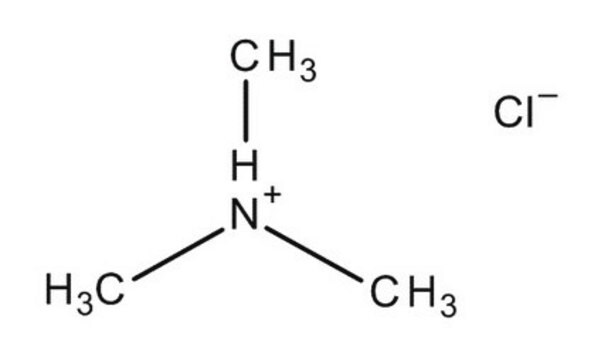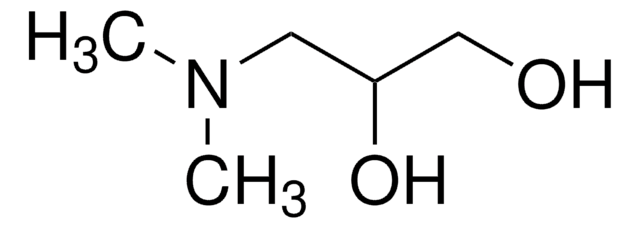348287
(3-Chloro-2-hydroxypropyl)trimethylammonium chloride solution
60 wt. % in H2O
Synonym(s):
3-chloro-2-hydroxy-propyltrimethylammonium chloride
Sign Into View Organizational & Contract Pricing
All Photos(1)
About This Item
Linear Formula:
ClCH2CH(OH)CH2N(Cl)(CH3)3
CAS Number:
Molecular Weight:
188.10
Beilstein:
6576172
MDL number:
UNSPSC Code:
12352101
PubChem Substance ID:
NACRES:
NA.22
Recommended Products
form
liquid
Quality Level
concentration
60 wt. % in H2O
refractive index
n20/D 1.4541
density
1.154 g/mL at 25 °C
SMILES string
[Cl-].C[N+](C)(C)CC(O)CCl
InChI
1S/C6H15ClNO.ClH/c1-8(2,3)5-6(9)4-7;/h6,9H,4-5H2,1-3H3;1H/q+1;/p-1
InChI key
CSPHGSFZFWKVDL-UHFFFAOYSA-M
Looking for similar products? Visit Product Comparison Guide
Related Categories
Application
(3-Chloro-2-hydroxypropyl)trimethylammonium chloride solution (CHTAC) can be used:
- As a cation-generating agent for cellulose cationization by exhaustion method.
- To resolve 2,2′-dihydroxy-1,1′-binaphthyl enantiomers.
- To synthesize cationic glycogen (Cat Gly).
- As a quaternizing agent for quaternization of N-aryl chitosan derivatives.
Signal Word
Warning
Hazard Statements
Precautionary Statements
Hazard Classifications
Aquatic Chronic 3 - Carc. 2
Storage Class Code
10 - Combustible liquids
WGK
WGK 2
Flash Point(F)
235.4 °F - closed cup
Flash Point(C)
113 °C - closed cup
Personal Protective Equipment
dust mask type N95 (US), Eyeshields, Gloves
Choose from one of the most recent versions:
Already Own This Product?
Find documentation for the products that you have recently purchased in the Document Library.
Customers Also Viewed
Efficient resolution of 2, 2′-dihydroxy-1, 1′-binaphthyl by inclusion complexation with chiral N-(3-chloro-2-hydroxypropyl)-N, N, N-trimethylammonium chloride
Toda F, et al.
Organic & Biomolecular Chemistry, 2(4), 449-451 (2004)
Reaction efficiency for cellulose cationization using 3-chloro-2-hydroxypropyl trimethyl ammonium chloride
Hashem M, et al.
Textile Res., 73(11), 1017-1023 (2003)
Synthesis, characterization and flocculation characteristics of cationic glycogen: a novel polymeric flocculant
Pal S, et al.
Colloids and Surfaces. A, Physicochemical and Engineering Aspects, 289(1-3), 193-199 (2006)
Zeeshan Khatri et al.
Carbohydrate polymers, 91(1), 434-443 (2012-10-10)
Continuous effort in research and development of nanofibers for apparel usage has been focused within their functional properties only. We investigated esthetic properties by producing colored cationic-cellulose nanofibers for the very first time for the potential application of apparel use.
Quaternization of N-aryl chitosan derivatives: synthesis, characterization, and antibacterial activity
Sajomsang W, et al.
Carbohydrate Research, 344(18), 2502-2511 (2009)
Our team of scientists has experience in all areas of research including Life Science, Material Science, Chemical Synthesis, Chromatography, Analytical and many others.
Contact Technical Service
![[2-(Methacryloyloxy)ethyl]trimethylammonium chloride solution 75 wt. % in H2O](/deepweb/assets/sigmaaldrich/product/structures/316/612/66b0f4cf-d060-427d-b4f5-e8fab3e5cffe/640/66b0f4cf-d060-427d-b4f5-e8fab3e5cffe.png)
![[2-(Acryloyloxy)ethyl]trimethylammonium chloride solution 80 wt. % in H2O, contains 600 ppm monomethyl ether hydroquinone as inhibitor](/deepweb/assets/sigmaaldrich/product/structures/393/326/f7e19585-5431-4220-81b5-f458de6d63d0/640/f7e19585-5431-4220-81b5-f458de6d63d0.png)



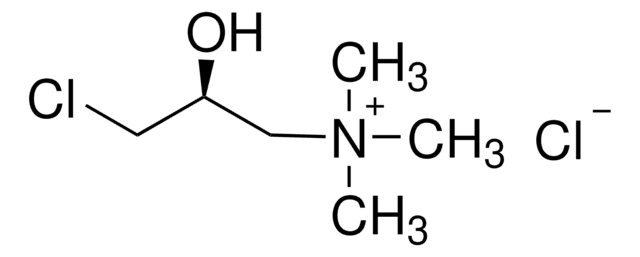
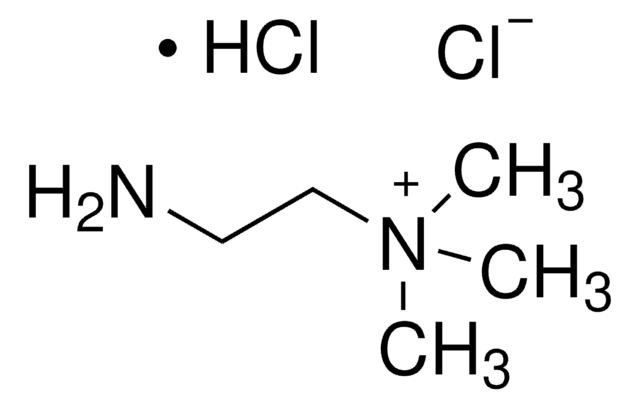
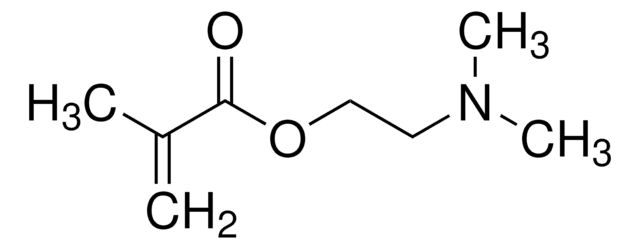
![N-[3-(Dimethylamino)propyl]methacrylamide 99%, contains MEHQ as inhibitor](/deepweb/assets/sigmaaldrich/product/structures/295/145/6b4aae15-7cb5-4b7b-9c06-8e6d24e50951/640/6b4aae15-7cb5-4b7b-9c06-8e6d24e50951.png)

